Solo Exhibition
TO MEET ON THE RIVERBEND
18.02.2025 - 19.04.2024
︎Nicodim Gallery L.A.
![]()
![]()
![]()
![]()
![]()
Abstraction has a historic connection to coldness, whether in the ab-ex association to depression or the academic approach to formalism which followed it. This style of abstraction foregrounds gesture. To paint without subject is to remove the burden of representation and, to instead enter the woods of pure form or pure expression - the artist sacrifices symbols and signifiers in favor of tones and textures. The communication of the work obscured, sat somewhere within the cascading brush strokes and fields of color. Historically asserted as a male-dominated practice, female painters and questions of femininity within the medium were eschewed in favor of the phallic bravado of the massive canvas - the endless battle between artist and surface.
Teresa Murta rejects this coldness, her works are full of undulating color drifting in and out of discernible shapes. The possibility of representation floats off as readily as it emerges, guiding the viewers across the surface by the hand. Heavy texture gives way to flat fields of pigment, balancing one another with the wilful intention of nature - viewers given the opportunity to gaze into turmoil whilst retaining the serenity of equilibrium.
To Meet on the Riverbend, Murta’s latest body of work, is a sneak peek into a family. The works are made together, with no canvas abandoned in the process of making. Refusing the torrid romance of the torn-up drawing, the kicked-through canvas, Murta nurtures the works as a unit. A closeness between the artist and the surfaces is developed through this working process, questions raised in one painting can be answered in another - balance is achieved through each work’s relationship to its sibling. In any familial unit, there are members who require more support and those who require less - this personification is inherent in Murta’s practice, working on canvases in unison almost as a means of sharing collective positive will.
Sharing, as a notion, equally applies to the space in which the works are conceived. With everything happening in unison, the studio becomes an incubator for works in varying sizes, densities and personalities. As formal qualities emerge in one work, the aura of the space shifts and balance is as likely to be found in a new painting as much as it is the one being worked on. The familial relationship of the works creates a unique formal disposition, one in which questions of composition, color and texture are discussed across multiple works - all in conversation with one another.
Stand-up - one of the largest works in the exhibition - undulates with waves of colour crashing into a central maelstrom, highlighting Murta’s understanding of painting’s formal concerns. The piece alludes towards a depth of field, without fully clarifying a foreground or background, slipping together around the edges and creating a surface locked in suspense. Contrasting this, To be held adopts clear separations between foreground and background, opting towards establishing a strong phenomenological connection around the texture and physicality of abstract forms.
In To Meet on the Riverbend, Teresa Murta challenges the historic legacy of abstract painting, applying new and idiomatic ways of considering a painting not just as an individual object but as a member of a broader body of work, existing with its own contextual purpose.
– Allan Gardner
Solo Exhibition
ONE SECOND PLAN
13.01.2024 - 16.03.2024
︎Galeria Bruno Múrias, Lisbon
R. Cap. Leitão 16
1950-051 Lisboa
![]()
ENG
In part, we could say that the very nature of painting presupposes images to which accessalways seems to be granted in a kind of half-way contract — the perception of the final imageis consented to as long as one accepts the absence of the image that precedes it. Perhaps it is,in fact, a metric negotiation between the reaction of the blank space and the superimpositionof layers that, more or less subtly, trigger the presence of different planes within a spacegoverned and limited by tangible edges where the visual composition begins to appear. OneSecond Plan, Teresa Murta’s (Lisbon, 1993) first exhibition at Galeria BRUNO MÚRIAS, thusdisassembles itself as an essayistic exercise relating to the discipline of painting itself which,like an essay, does not wish to seek out and filter the eternal from the transitory, but rather tomake the transitory eternal, and the particular transparent to universal categories(1) — naturally
independent of the concepts of a first principle and an ultimate end.
There is a succession of formal characteristics in the works — which vary in large and smallscale formats — that make it possible for a pictorial energy to appear that is both fleetingand languid, unfolding the intertwined images into double meanings and hidden corners inpure syntheses of abstractions and chromatic, volumetric and allegorical digressions, as thetitle of the exhibition suggests. One second plane — of action, composition, montage — orthe sleepless moment of a one second plane. The motifs — let us call them apparent figures,events, landscapes — appear restless in their static condition, overwhelmed by the vertigo ofa resolution that never concludes — a sleep that never deepens, a yawn that never leaves, astretch without relief — as if discomfort were an inevitable impermanence whose contourswe cannot grasp. The apprehension of a gesture is quickly invaded by another movement,somehow preventing that image from closing and summoning a new trajectory for that samebody, scale, detail that, crossed by another spectrum, remains in suspension, unharmed.
Radiating traces of their passing, the images open up into images, springing up in echoes ateach limit that coincides with the birth of another, ceasing only when they meet a vanishingpoint that dissipates into the sense of depth simulated by luminances and perspectives thatescape the gaze.Refraining from the temptation to decipher, one could say that these paintings are, despitetheir acrimony and distinction, objects of ineffable reading. If, on the one hand, they allow us tosense the relative weight of intention, enunciated and translated by all the images of memory,and the weight of desire, detached and mobilised by sensitivity; on the other hand, they annuland decontextualise any trace of even primary identification with regard to Ideas and conceptsthat necessarily exist insofar as they are innate. Therefore, they do not escape them and arenot absent from them. The images are there, in transmutation and movement, governed by theforce of composition, drawing and the complex formality they contain within themselves andat their pictorial core. The use of contrasting scales in itself determines the verification of animbalance that we can intuitively discern in the conclusions of a first encounter with the interiorof the painting, almost as if we had already accessed it before it reached this body (that of thepainting).
The works rise up around the room like stained glass windows, milky portals, but with a rigorousvisual acuity. The painting, like the essay, is united to the stripping away of expectation, to pureform, to the quantum of being before the unrestricted enigma of the image, as of the word.Like it, it attributes ontological dignity to the result of abstraction, to the concept invariable intime, as opposed to the individual subsumed within it.(2)
Solo Exhibition
PURPLE HAZE, BUT BETTER TOGETHER
2023
︎Tabula Rasa Gallery, London
Unit 1, 99 East Rd
London

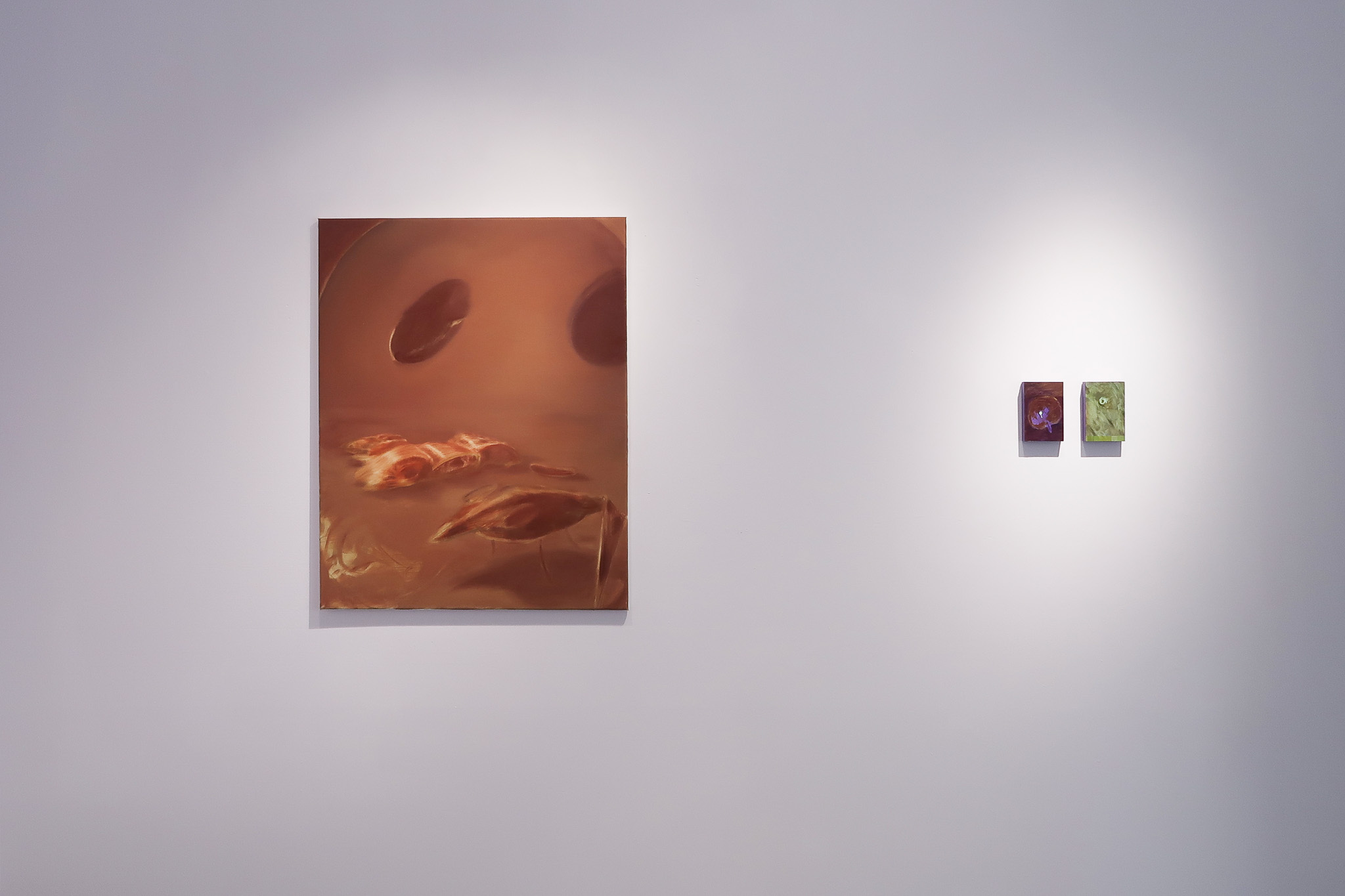

ENG
Collective Exhibition
0/1 O ZERO E O UM
Until - 08.01.2022
︎Museu de História Natural e da Ciência
R. da Escola Politécnica 56,
1250-102 Lisboa
![]()
![]()
PT
Solo Exhibitions
Fishnet
13.09.2022 - 03.10.2022
︎Camões Berlin
Zimmerstraße 55, 10117 Berlin
10117 Berlin
TO MEET ON THE RIVERBEND
18.02.2025 - 19.04.2024
︎Nicodim Gallery L.A.
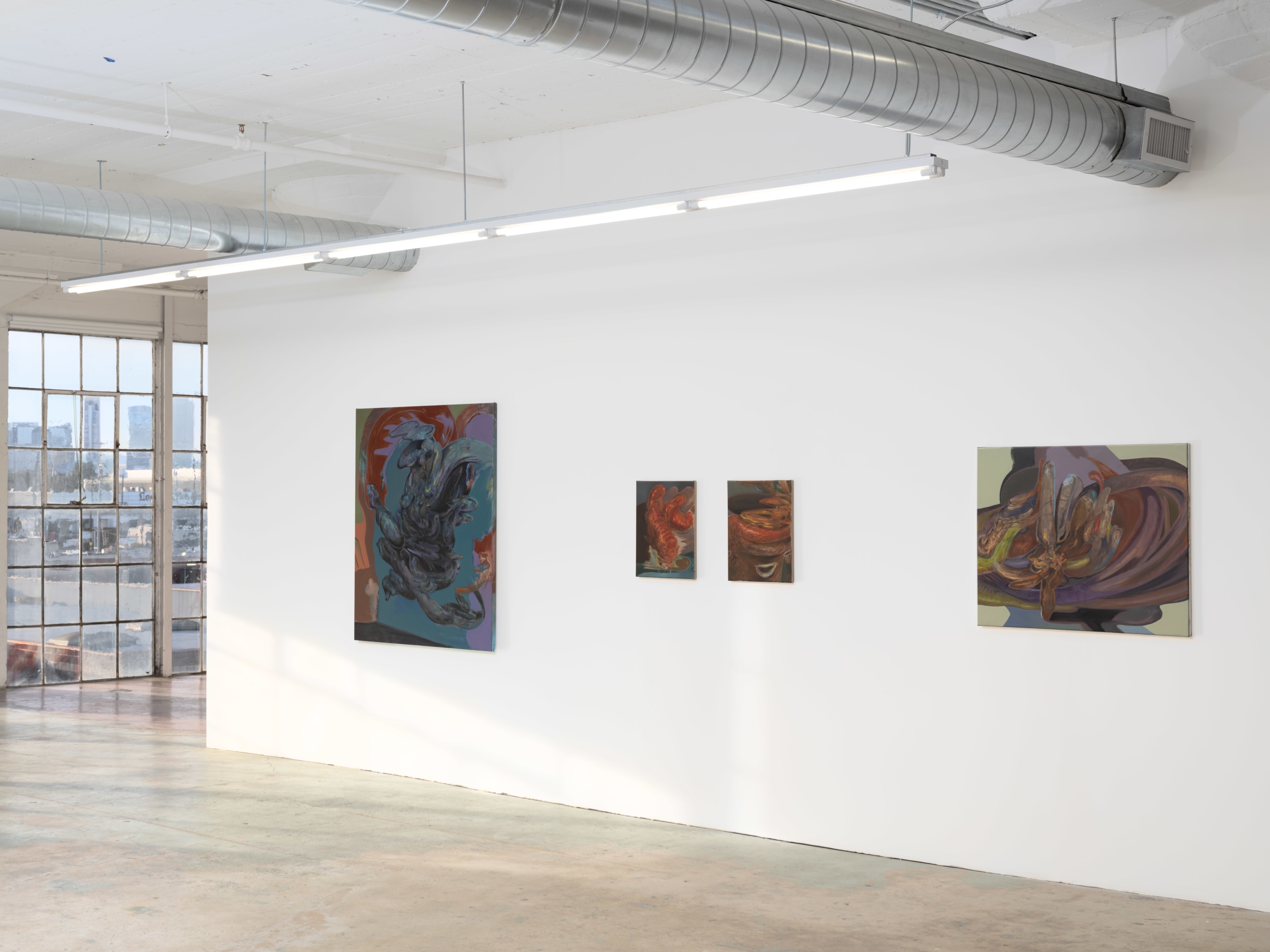

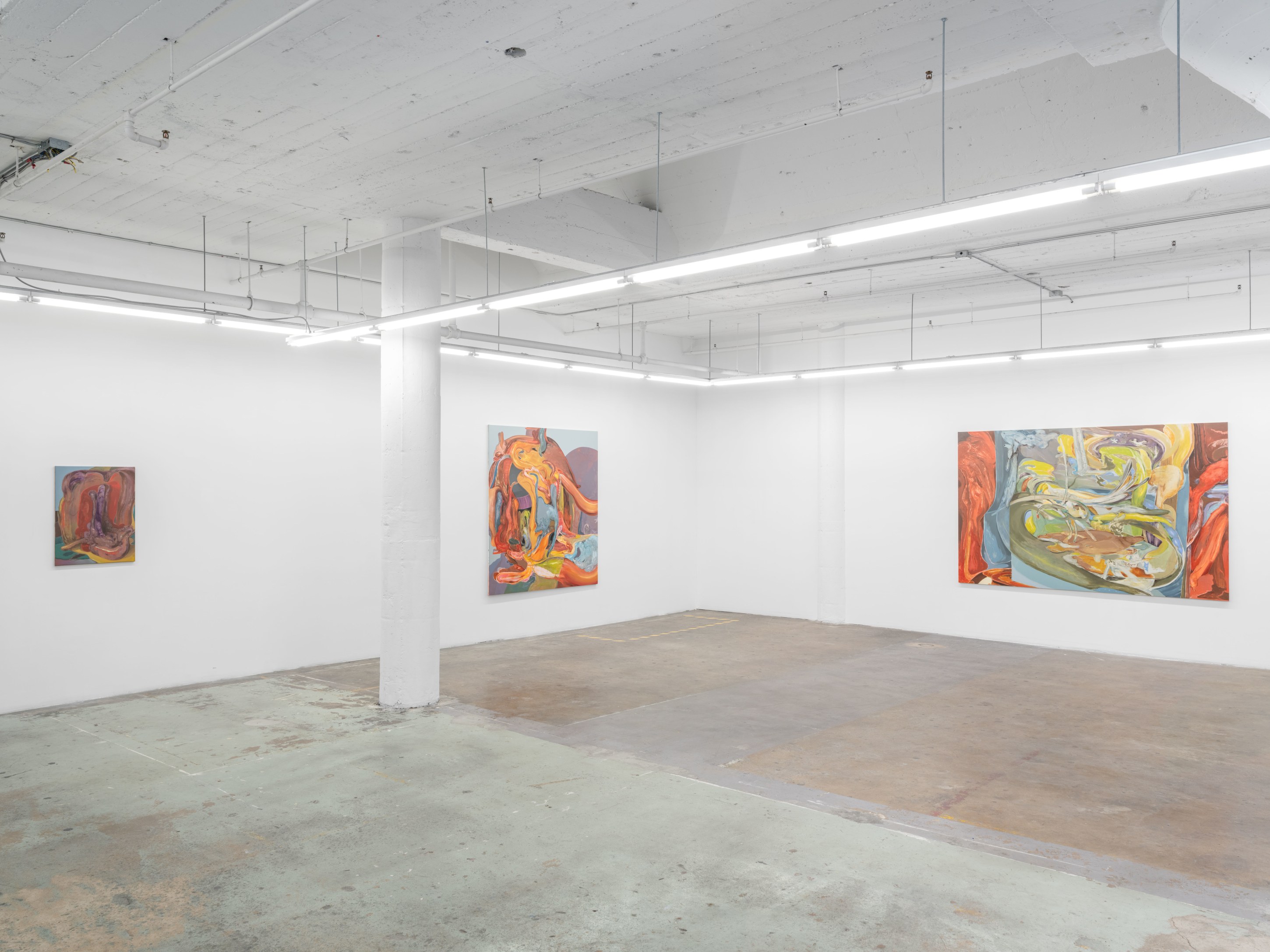

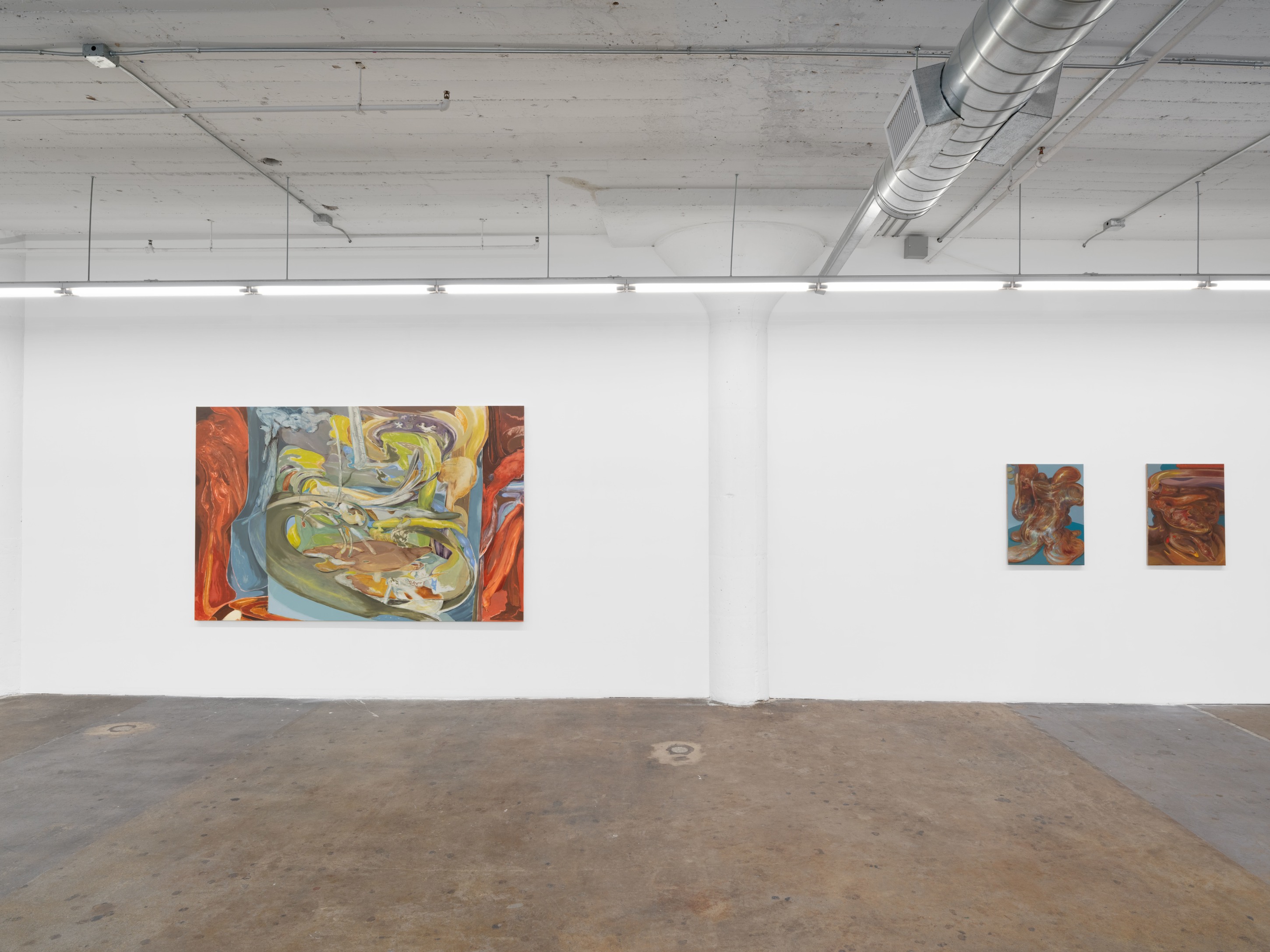
Abstraction has a historic connection to coldness, whether in the ab-ex association to depression or the academic approach to formalism which followed it. This style of abstraction foregrounds gesture. To paint without subject is to remove the burden of representation and, to instead enter the woods of pure form or pure expression - the artist sacrifices symbols and signifiers in favor of tones and textures. The communication of the work obscured, sat somewhere within the cascading brush strokes and fields of color. Historically asserted as a male-dominated practice, female painters and questions of femininity within the medium were eschewed in favor of the phallic bravado of the massive canvas - the endless battle between artist and surface.
Teresa Murta rejects this coldness, her works are full of undulating color drifting in and out of discernible shapes. The possibility of representation floats off as readily as it emerges, guiding the viewers across the surface by the hand. Heavy texture gives way to flat fields of pigment, balancing one another with the wilful intention of nature - viewers given the opportunity to gaze into turmoil whilst retaining the serenity of equilibrium.
To Meet on the Riverbend, Murta’s latest body of work, is a sneak peek into a family. The works are made together, with no canvas abandoned in the process of making. Refusing the torrid romance of the torn-up drawing, the kicked-through canvas, Murta nurtures the works as a unit. A closeness between the artist and the surfaces is developed through this working process, questions raised in one painting can be answered in another - balance is achieved through each work’s relationship to its sibling. In any familial unit, there are members who require more support and those who require less - this personification is inherent in Murta’s practice, working on canvases in unison almost as a means of sharing collective positive will.
Sharing, as a notion, equally applies to the space in which the works are conceived. With everything happening in unison, the studio becomes an incubator for works in varying sizes, densities and personalities. As formal qualities emerge in one work, the aura of the space shifts and balance is as likely to be found in a new painting as much as it is the one being worked on. The familial relationship of the works creates a unique formal disposition, one in which questions of composition, color and texture are discussed across multiple works - all in conversation with one another.
Stand-up - one of the largest works in the exhibition - undulates with waves of colour crashing into a central maelstrom, highlighting Murta’s understanding of painting’s formal concerns. The piece alludes towards a depth of field, without fully clarifying a foreground or background, slipping together around the edges and creating a surface locked in suspense. Contrasting this, To be held adopts clear separations between foreground and background, opting towards establishing a strong phenomenological connection around the texture and physicality of abstract forms.
In To Meet on the Riverbend, Teresa Murta challenges the historic legacy of abstract painting, applying new and idiomatic ways of considering a painting not just as an individual object but as a member of a broader body of work, existing with its own contextual purpose.
– Allan Gardner
Solo Exhibition
ONE SECOND PLAN
13.01.2024 - 16.03.2024
︎Galeria Bruno Múrias, Lisbon
R. Cap. Leitão 16
1950-051 Lisboa

ENG
In part, we could say that the very nature of painting presupposes images to which accessalways seems to be granted in a kind of half-way contract — the perception of the final imageis consented to as long as one accepts the absence of the image that precedes it. Perhaps it is,in fact, a metric negotiation between the reaction of the blank space and the superimpositionof layers that, more or less subtly, trigger the presence of different planes within a spacegoverned and limited by tangible edges where the visual composition begins to appear. OneSecond Plan, Teresa Murta’s (Lisbon, 1993) first exhibition at Galeria BRUNO MÚRIAS, thusdisassembles itself as an essayistic exercise relating to the discipline of painting itself which,like an essay, does not wish to seek out and filter the eternal from the transitory, but rather tomake the transitory eternal, and the particular transparent to universal categories(1) — naturally
independent of the concepts of a first principle and an ultimate end.
There is a succession of formal characteristics in the works — which vary in large and smallscale formats — that make it possible for a pictorial energy to appear that is both fleetingand languid, unfolding the intertwined images into double meanings and hidden corners inpure syntheses of abstractions and chromatic, volumetric and allegorical digressions, as thetitle of the exhibition suggests. One second plane — of action, composition, montage — orthe sleepless moment of a one second plane. The motifs — let us call them apparent figures,events, landscapes — appear restless in their static condition, overwhelmed by the vertigo ofa resolution that never concludes — a sleep that never deepens, a yawn that never leaves, astretch without relief — as if discomfort were an inevitable impermanence whose contourswe cannot grasp. The apprehension of a gesture is quickly invaded by another movement,somehow preventing that image from closing and summoning a new trajectory for that samebody, scale, detail that, crossed by another spectrum, remains in suspension, unharmed.
Radiating traces of their passing, the images open up into images, springing up in echoes ateach limit that coincides with the birth of another, ceasing only when they meet a vanishingpoint that dissipates into the sense of depth simulated by luminances and perspectives thatescape the gaze.Refraining from the temptation to decipher, one could say that these paintings are, despitetheir acrimony and distinction, objects of ineffable reading. If, on the one hand, they allow us tosense the relative weight of intention, enunciated and translated by all the images of memory,and the weight of desire, detached and mobilised by sensitivity; on the other hand, they annuland decontextualise any trace of even primary identification with regard to Ideas and conceptsthat necessarily exist insofar as they are innate. Therefore, they do not escape them and arenot absent from them. The images are there, in transmutation and movement, governed by theforce of composition, drawing and the complex formality they contain within themselves andat their pictorial core. The use of contrasting scales in itself determines the verification of animbalance that we can intuitively discern in the conclusions of a first encounter with the interiorof the painting, almost as if we had already accessed it before it reached this body (that of thepainting).
The works rise up around the room like stained glass windows, milky portals, but with a rigorousvisual acuity. The painting, like the essay, is united to the stripping away of expectation, to pureform, to the quantum of being before the unrestricted enigma of the image, as of the word.Like it, it attributes ontological dignity to the result of abstraction, to the concept invariable intime, as opposed to the individual subsumed within it.(2)
A Night-Piece
The sky is overcast
With a continuous cloud of texture close,
Heavy and wan, all whitened by the Moon,
Which through that veil is indistinctly seen,
A dull, contracted circle, yielding light
So feebly spread, that not a shadow falls,
Chequering the ground — from rock, plant, tree, or tower.
At length a pleasant instantaneous gleam
Startles the pensive traveller while he treads
His lonesome path, with unobserving eye
Bent earthwards; he looks up — the clouds are split
Asunder, — and above his head he sees
The clear Moon, and the glory of the heavens.
There, in a black-blue vault she sails along,
Followed by multitudes of stars, that, small
And sharp, and bright, along the dark abyss
Drive as she drives: how fast they wheel away,
Yet vanish not! — the wind is in the tree,
But they are silent; — still they roll along
Immeasurably distant; and the vault,
Built round by those white clouds, enormous clouds,
Still deepens its unfathomable depth.
At length the Vision closes; and the mind,
Not undisturbed by the delight it feels,
Which slowly settles into peaceful calm,
Is left to muse upon the solemn scene.
William Wordsworth (1798)
(1)As developed by Theodor W. Adorno in “Notes on Literature I: The Essay as Form”, Editora 34, 2003.2W.
(2)Adorno, Theodor, in “Notes on Literature I: The Essay as Form”, Editora 34, 2003, p.25.
The sky is overcast
With a continuous cloud of texture close,
Heavy and wan, all whitened by the Moon,
Which through that veil is indistinctly seen,
A dull, contracted circle, yielding light
So feebly spread, that not a shadow falls,
Chequering the ground — from rock, plant, tree, or tower.
At length a pleasant instantaneous gleam
Startles the pensive traveller while he treads
His lonesome path, with unobserving eye
Bent earthwards; he looks up — the clouds are split
Asunder, — and above his head he sees
The clear Moon, and the glory of the heavens.
There, in a black-blue vault she sails along,
Followed by multitudes of stars, that, small
And sharp, and bright, along the dark abyss
Drive as she drives: how fast they wheel away,
Yet vanish not! — the wind is in the tree,
But they are silent; — still they roll along
Immeasurably distant; and the vault,
Built round by those white clouds, enormous clouds,
Still deepens its unfathomable depth.
At length the Vision closes; and the mind,
Not undisturbed by the delight it feels,
Which slowly settles into peaceful calm,
Is left to muse upon the solemn scene.
William Wordsworth (1798)
Eva Mendes
2023
(1)As developed by Theodor W. Adorno in “Notes on Literature I: The Essay as Form”, Editora 34, 2003.2W.
(2)Adorno, Theodor, in “Notes on Literature I: The Essay as Form”, Editora 34, 2003, p.25.
Solo Exhibition
PURPLE HAZE, BUT BETTER TOGETHER
2023
︎Tabula Rasa Gallery, London
Unit 1, 99 East Rd
London



ENG
In a sonic landscape filled with diverse sounds and influences, Hendrix’s Purple Haze transcends boundaries and offers a one-of-a-kind auditory experience. The song’s mesmerising melodies, coupled with Hendrix’s innovative guitar techniques, evoke a sense of euphoria and disorientation all at once. These sensory perceptions are mirrored when first encountering Murta’s paintings. imbued with a rich and poetic palette, they energise the canvas. Bold hues and contrasting tones create a sense of dynamism, drawing the viewer’s attention, evoking strong emotional responses.
Excerpt from “Purple Haze”
James Ambrose
Independent writer, curator and head of production émergent magazine.
2023
Collective Exhibition
0/1 O ZERO E O UM
Until - 08.01.2022
︎Museu de História Natural e da Ciência
R. da Escola Politécnica 56,
1250-102 Lisboa
PT
No princípio era o verbo, no princípio é a imaginação.
A exposição (0/1) o zero e o um, apresenta-se em vários locais do Museu Nacional de História Natural e da Ciência: no Átrio, no Anfiteatro do Laboratorio de Chimica, no Claustro, no Laboratório de Química Analítica e no Corredor da Geologia. O tema da exposição é baseado no livro, Atlas do corpo e da imaginação. Teoria, fragmentos e imagens de Gonçalo M. Tavares. “Digamos que, por mais possibilidades que a imaginação possa ter, o seu último lance é reduzir as infinitas possibilidades a duas e, de entre estas duas, por fim, escolher uma. Só assim a imaginação pode passar para o exterior, pois no exterior não há tempos duplos. Podemos fazer uma coisa e depois o seu oposto, mas não podemos ao mesmo tempo fazer uma coisa e o seu oposto.” (1) Aqui os artistas vão habitar o espaço com os seus trabalhos, trabalhos esses que contribuem para se ir fazendo um caminho como um percurso inacabado. “Marcar uma certa linha num certo instante não permita a previsão certeira do próximo passo.”(2)
Artistas com percursos e formação distintos, alguns trabalhos que se cruzam, outros que se completam e ainda outros que seguem caminhos paralelos, mas todos perseguem o conceito da materialização, da corporização. “Uma casa habitada deixa de ser um espaço para passar a ser aquilo que rodeia um corpo.”(3) Trabalhos artísticos que ocupam e se inscrevem neste espaço museológico e inexoravelmente apenas se concretizam quando a ideia, o conceito se materializa.
Citando a galerista Mercedes Cerón, promotora da exposição, “(0/1) o zero e o um, reflete sobre a imaginação e os conceitos de oposição, a arbitrariedade da interpretação e sobre a qual, a imaginação se foca através da representação da realidade ou dos objetos e não da coisa em si. A variedade de enunciados, reproduzindo metáforas multiplicando as possibilidades de verdade – uma espécie de ciência momentânea.”
A narrativa visual e estética não acaba enquanto a sua idealização e imaginação deixar de se materializar .“Nem a matéria, nem o espaço, nem o tempo são desde há vinte anos o que foram até então. É de esperar que tão grandes inovações modifiquem toda a técnica das artes, agindo, desse modo, sobre a própria invenção, chegando talvez mesmo a modificar a própria noção de arte em termos mágicos.”(4). No princípio era o verbo, no princípio é a imaginação.
Sofia Marçal,
November 2022
1 Gonçalo M. Tavares, in: Atlas do corpo e da imaginação. Teoria, fragmentos e imagens de, p.395.
2 Ob. cit, Gonçalo M. Tavares, p.31.
3 Ob. cit, Gonçalo M. Tavares, p.414.
4 Walter Benjamim, in: A Obra de Arte na era da sua reprodutibilidade técnica, p.1.
Solo Exhibitions
Fishnet
13.09.2022 - 03.10.2022
︎Camões Berlin
Zimmerstraße 55, 10117 Berlin
10117 Berlin


ENG
Internal and external.
There is a belief that the world is, in its essence, indifferent and impenetrable in relation to human attempts to discover its deepest reason. The individual struggles to find meaning in a meaningless world and in simultaneity emphasizes the epistemic inability of reason to penetrate and understand reality. This collision between an internal component belonging to human nature, and an external component belongingto the nature of the world, persists in the human being who lives his existence in search of his essence, hismeaning, and finds a disconnected and unintelligible world as in " Myth of Sisyphus” by Albert Camus. The search for meaning, unity and clarity as an eternalization of a task - a paradox of modern life, which Teresa Murta presents in “Fishnet” as a pictorial diary, a visual and affective barometer of her experience in the lasttwelve months in Berlin, is perpetuated in the his paintings as a record of an emotional, intuitive and free process,loaded with enormous epistemological scepticism. Although, however, the spectator interprets the explosiveshapes and spots with serenity - as if there was a complicit understanding with the artist, due to the absurdity ofexperimenting with similar references, because at some point or place, the imaginary touches and meets. Themoment when thought denies the truths that the hands can touch, the moment when the internal is not nonsense: but only taken seriously. From the mental and poetic figuration of the meaning of fishnet, and the cognitive symbolism, Murta guides the viewer through his artistic process of sealing and uncovering images, actions and choices, facing the possibility that everything can have a meaning even if it is merely factual.
Mercedes Cerón
September 2022
Solo Exhibitions
Frozen Eggs and Wet Panties
29.04.2022 - 27.05.2022
︎Uhura Basement
Weydemeyerstraße 2,
10178 Berlin

ENG
In her first solo show in Germany the Portuguese artist Teresa Murta is displaying her most recent series of works at Uhura Basement in Berlin. With Frozen eggs and wet panties the artist portrays a very specific period of time - the time in between youth and adulthood - experienced from her perspective as a young European woman.
This is a time characterized by an exciting struggle scrutinizing what we have been taught so far and exploring things anew. In this stage of life, where we reach a more complex understanding of the world, of our bodies, our sexuality, our personality and of how we are embedded in a greater sociocultural context. We start to realize and question behavioral patterns, learned and inherited in social rites that became our identity. Old traditions and morals might become untimely and we live by new values. Nowadays, this gap between youth and adulthood seems to be stretched to sheer infinity.
It’s a phenomenon which occurs especially in the generations following the baby boomers: generation x, the millennials and possibly generation z.
While in previous generations the way of life was largely an already given path, today many of us have the privilege to choose from a plethora of possibilities. But this privilege also has its downsides: We can lose ourselves in this abundance and it can lead to a paralyzing overload.
During this time, we not only experience the wonderful sides of previously unknown freedoms, no, we also gradually become aware of the evanescence of our youth and the restraints our bodies have over our lives. Especially as women, this is the time where we start to hear our biological clock tick. But thanks to the possibility of freezing our eggs and other rejuvenating procedures, we can silence this ticking for another while. By setting aside a safety cushion of unborn childhoods, we buy ourselves the freedom to focus on a more carefree and hedonistic lifestyle for just a little longer.
As intriguing as these new found freedoms may sound, there is also a little warning in Teresa Murta’s exhibition: If we play for too long in this period of being undefined in between, we might lose what is most precious. If we do not remind us of our dreams- we might just flush them away like yet another bloodily exuded unfertilized egg.
Teresa Murta mainly creates series of paintings that are dedicated to one specific theme complex or time frame. There is no explicit narrative but yet a dialogue between the separate works of one series. Her artistic practice is characterized by various antitheses. While painting she tries to merge the two different realms of the intuitive-aesthetic and the rational-intellectual – the child and the adult - to reach an elevated state of mind for creating her work.
In her paintings she is confronting realistic and figurative elements with abstract forms. Thereby her works are informed by a tension between something that seems familiar and immediately recognizable and something surreal and marvelous. These elements can change their form in whoever is laying their eyes on them, exposing our perception, which leaves us with an intriguing suspense.
Murta chooses some specific objects from her perceptual world as indirect references for the complex psychosocial and cultural structures that she is debating in her works.
So can a tent become a metaphor for the childhood or a glove in a dainty gesture, a placeholder for an old ideal that has been and is still being taught to our daughters’ hands: the good fairy of the house, keeping it clean and tidy with ease.
While working on a series, Murta also finds complementary inspirations in art history. Works that she encounters like synchronicities. For example in the painting The excommunication of Robert the Pious (le Pieux) from 1875, by Jean-Paul Laurens, where the old morals have left the room and the king is now free to pursue his own ideal of happiness.
Teresa Murta starts her painting process either with a spontaneous impulse on the canvas, or on the contrary, with one of these precise objects, that have a strong symbolic value for the artist. Each work is like a challenge that she meets with the same obsession as if solving a problem. She steps into an aesthetic dialogue with the painting until it develops into its final state. During that process, the initial form might disappear completely or reappear in an evolved form in the painting or somewhere else in the series.
In A portrait of a storm, she proceeded that practice to a climax.
What was once the starting point of the work, has been extinguished, painted over and over, changed beyond recognition into something completely new. But the meaning, the essence of the initial object has passed into the painting. It abides in the background and the work radiates its sublime aura. That what lays beyond the surface – it remains perceptible.
Judith Hofer,
Independent curator and writer
April 2022
DE
In ihrer ersten Einzelausstellung in Deutschland, im Uhura Basement in Berlin, präsentiert die portugiesische Künstlerin Teresa Murta ihre jüngst entstandene Reihe an Malereien. Mit Frozen eggs and wet panties porträtiert die Künstlerin eine ganz besondere Zeit – die Zeit zwischen Jugend und Erwachsenensein – erlebt aus ihrer Perspektive als junge Europäerin.
Es ist eine wunderbar spannende und grauenhaft aufregende Zeit, die von einem aufreibenden Ringen geprägt ist: Wir werden uns allmählich der Verhaltensmuster, Moralvorstellungen und Traditionen, die uns von der Gesellschaft und in unseren Familien gelehrt worden sind, bewusst. Wir beginnen sie zu hinterfragen und fangen an nach eigens gewählten Werten zu leben. In diesem Lebensabschnitt erkunden wir viel Neues und erlangen so ein komplexeres Verständnis über die Welt und über unsere eigene Einbettung in einen größeren soziokulturellen Kontext. Wir erlangen ein neues Bewusstsein über unseren Körper, unsere Sexualität, unsere Persönlichkeit und Identität.
Heutzutage scheint dieser Zwischenzustand, in dem man nicht mehr jugendlich, aber auch noch nicht recht erwachsen ist, bis ins Unendliche ausgedehnt zu werden. Es ist ein Phänomen das besonders in den Generationen nach den Babyboomern auftritt: in der Generation X, den Millennials und möglicherweise auch in der Generation Z.
Während in den vorangegangenen Generationen der Lebensweg größtenteils schon vorgezeichnet war, haben heutzutage viele von uns das Privileg, aus einer Überfülle von Möglichkeiten auszuwählen. Dieses Privileg hat aber auch seine Schattenseiten: Wir können uns in diesem Überfluss, bis hin zu einer lähmenden Überforderung, verlieren.
In dieser Zeit erleben wir nicht nur die wunderbaren Seiten bisher unbekannter Freiheiten, nein, wir werden uns allmählich auch der Vergänglichkeit unserer Jugend und der Einschränkungen, die unser Körper über unser Leben hat, bewusst.
Vor allem für uns Frauen ist dies die Zeit, in der wir beginnen unsere biologische Uhr ticken zu hören. Doch dank der Möglichkeit, unsere Eizellen einzufrieren und anderer Verjüngungsverfahren, können wir auch dieses Ticken noch für ein Weilchen wieder verstummen lassen. Wir legen uns ein Sicherheitspolster ungeborener Kindheiten beiseite und erkaufen uns damit die Freiheit uns noch etwas länger auf einen sorgloseren und hedonistischen Lebensstil zu konzentrieren.
So einladend diese neu gewonnenen Freiheiten auch klingen mögen, es findet sich doch eine kleine Warnung in Teresa Murtas Ausstellung: Wenn wir uns in dieser Zeit des Undefinierten-Dazwischen zu lange austoben, könnten wir das Kostbarste verlieren. Wenn wir uns nicht unserer Träume besinnen, könnten wir sie einfach hinwegspülen wie ein weiteres blutig-ausgeschiedenes unbefruchtetes Ei.
In ihrer künstlerischen Arbeit beschäftigt sich Teresa Murta immer mit einem bestimmten Themenkomplex oder einem spezifischen Zeitraum, welchem sie dann eine Reihe an Malereien widmet. Es gibt kein explizites Narrativ, aber dennoch einen wandelbaren Dialog zwischen den einzelnen Werken einer Serie.
Ihre künstlerische Praxis ist von sich vereinenden Antithesen geprägt.
Während ihres Schaffensprozesses versucht sie die gegensätzlichen Bereiche des Intuitiv-Ästhetischen und des Rational-Intellektuellen – des Kindes und des Erwachsenen – zu vereinen um so in einem besonderen Bewusstseinszustand ihre Werke zu erschaffe.
In ihrer Malerei konfrontiert sie realistische und figurative Elemente mit Abstraktem. Somit sind ihre Arbeiten von einer Spannung zwischen etwas Vertrautem und sofort Erkennbarem und etwas Surrealem und Wunderbarem geprägt. Teresa Murtas Arbeiten spielen mit unserer Wahrnehmung- sie entlarvt sie geradezu, da sich die Elemente in den Augen derer, die sie erblicken, zu immer wieder anderen Formen verändern.
Murta wählt einige spezifische Objekte aus ihrer Wahrnehmungswelt als indirekte Referenzen für die komplexen psychosozialen und kulturellen Strukturen, die sie in ihren Arbeiten diskutiert. So kann ein Zelt zur Metapher für die Kindheit werden oder ein Handschuh in einer gezierten Geste, zu einem Platzhalter für ein altes Ideal, das den Händen unserer Töchter noch immer beigebracht wird: die gute Fee des Hauses, die es mit Leichtigkeit und Eleganz sauber und ordentlich hält.
Während der Arbeit an einer Serie findet Murta auch ergänzende Inspirationen in der Kunstgeschichte. Werke, die ihr wie Synchronizitäten begegnen. So zum Beispiel in dem Gemälde Die Exkommunikation Roberts des Frommen von Jean-Paul Laurens aus dem Jahr 1875, wo die alten Sitten und Moralen den Raum verlassen haben und der König nun frei ist, seinem eigenen Glücksideal nachzugehen.
Den Prozess des Malens beginnt Teresa Murta entweder mit einem spontan-intuitiven Impuls auf der Leinwand oder im Gegenteil mit eben einem dieser präzisen Objekte, die für die Künstlerin einen starken Symbolwert haben. Jede Arbeit ist wie eine Herausforderung, der sie mit der gleichen Obsession begegnet, als würde sie ein Problem lösen. Sie tritt mit dem Gemälde in einen ästhetischen Dialog, bis sich sein endgültiger Zustand herausgebildet hat. Während dieses Prozesses kann die ursprüngliche Form vollständig verschwinden oder in einer weiterentwickelten Form im selben oder auch in einem anderen Gemälde wieder auftauchen.
In A portrait of a storm führte sie diese Praxis zu einem Höhepunkt.
Was einst der Ausgangspunkt der Arbeit war, wurde ausgelöscht, übermalt, bis zur Unkenntlichkeit in etwas völlig Neues verwandelt. Aber die Bedeutung, die Essenz des ursprünglichen Objekts ist in das Bild übergegangen. Sie bleibt im Hintergrund und das Werk strahlt seine erhabene Aura aus. Das, was hinter der Oberfläche, hinter dem Sichtbaren liegt, verbleibt noch immer wahrnehmbar.
Judith Hofer,
Independent curator and writer
April 2022
Solo Exhibitions
Whistle, Whistle
11.11.2021 - 22.01.2022
︎Nave
Travessa do Noronha n11 B
Lisboa
![]()
Collective Exhibition
Sine qua non
11.11.2021 - 22.01.2022
︎Nave
Travessa do Noronha n11 B
Lisboa
![]()
Solo Exhibitions
Airbag
2021
︎Aldama Fabre
Hiru Zutabe Plaza 7, 48003
Bilbao
Whistle, Whistle
11.11.2021 - 22.01.2022
︎Nave
Travessa do Noronha n11 B
Lisboa

Collective Exhibition
Sine qua non
11.11.2021 - 22.01.2022
︎Nave
Travessa do Noronha n11 B
Lisboa

Solo Exhibitions
Airbag
2021
︎Aldama Fabre
Hiru Zutabe Plaza 7, 48003
Bilbao

ES
La obra artística que Teresa Murta nos preparó, persiste en una modelación figurativa de elementos anímicos que suponen la mirada curiosa de nuestra propia interpretación. Estos diálogos abiertos entre la artista y la obra, sobrepasan su momento solitario – “la belleza no se reproduce, necesita que la reproduzcan” (Jean Lescure), y resulta en una abstracción de espanto en el público.
AIRBAG es una afirmación durmiente sobre el control y la tolerancia de lo desconocido, la responsabilidad de estar a los mandos de una dirección que nos encamina a una terrible ansiedad de un vacío. Murta, nos sugiere un dripping con una fuerte influencia onírica de pintura automática y que ella identifica como siendo su gestualismo personal.
En este diálogo de ensayo intuitivo de Teresa, el arte se liberta de las imposiciones de la lógica y de la razón, dejándose llevar por la consciencia cotidiana, en que la belleza es un paradojo que surge no sólo de la reunión de elementos dispares, pero de la fuerza de los momentos que anteceden la representación en la tela. Teresa las modela en su pintura de forma libre, a través de una plasticidad y transparencia que en cada camada expresa variación y movimiento y en simultaneo pausa y vacío, que la artista impone como un momento de observación.Lo maravilloso de Murta emerge del cotidiano y nos es revelado sin cualquier tipo de pirotecnia.
Un mundo de reflejos y ensayos de conceptos creativos de una realidad, donde ayer, hoy y mañana son siempre un tiempo presente, el único tiempo posible en la obra de Teresa Murta.
“If everything is real... then nothing is real as well” – The Angriest Dog in the World, 1973 David Lynch.
ENG
The artwork to which Teresa Murta has accustomed us, persists in the figurative modelling of soul elements that presuppose our curious gaze and our own interpretation. These open dialogues between the artist and the work go beyond their solitary moment - "beauty cannot reproduce itself, it must be reproduced" (Jean Lescure), and result in a reflection of astonishment in the viewer.
AIRBAG is an intoxicated statement about the control and acceptance of the unknown, the responsibility of being in charge of a direction that refers to the terrible consternation of the void. Murta suggests to us a dripping of strong oneiric influence of automatic painting which she identifies as her action painting.
In this dialogue of intuitive experimentation by Teresa, art frees itself from the impositions of logic and reason and goes beyond everyday consciousness, where beauty is a paradox, which arises not only from the gathering of disparate elements, but from the strength of the moments that precede the representation on canvas. She models them in her painting according to her will, through plasticity and transparency, where each layer reflects change and movement and even pause and emptiness, which the artist imposes as a moment of observation. The wonder of Murta emerges from everyday life and is revealed to us without any pyrotechnics.
A world of reflections and essays to create a reality, where yesterday, today and tomorrow are always the present time, the only possible time in Teresa Murta's artwork.
“If everything is real... then nothing is real as well” – The Angriest Dog in the World, 1973 David Lynch.
Mercedes Cerón, art director
Solo Exhibitions
Absurdo
2020
︎Nave
Travessa do Noronha n11 B
Lisboa
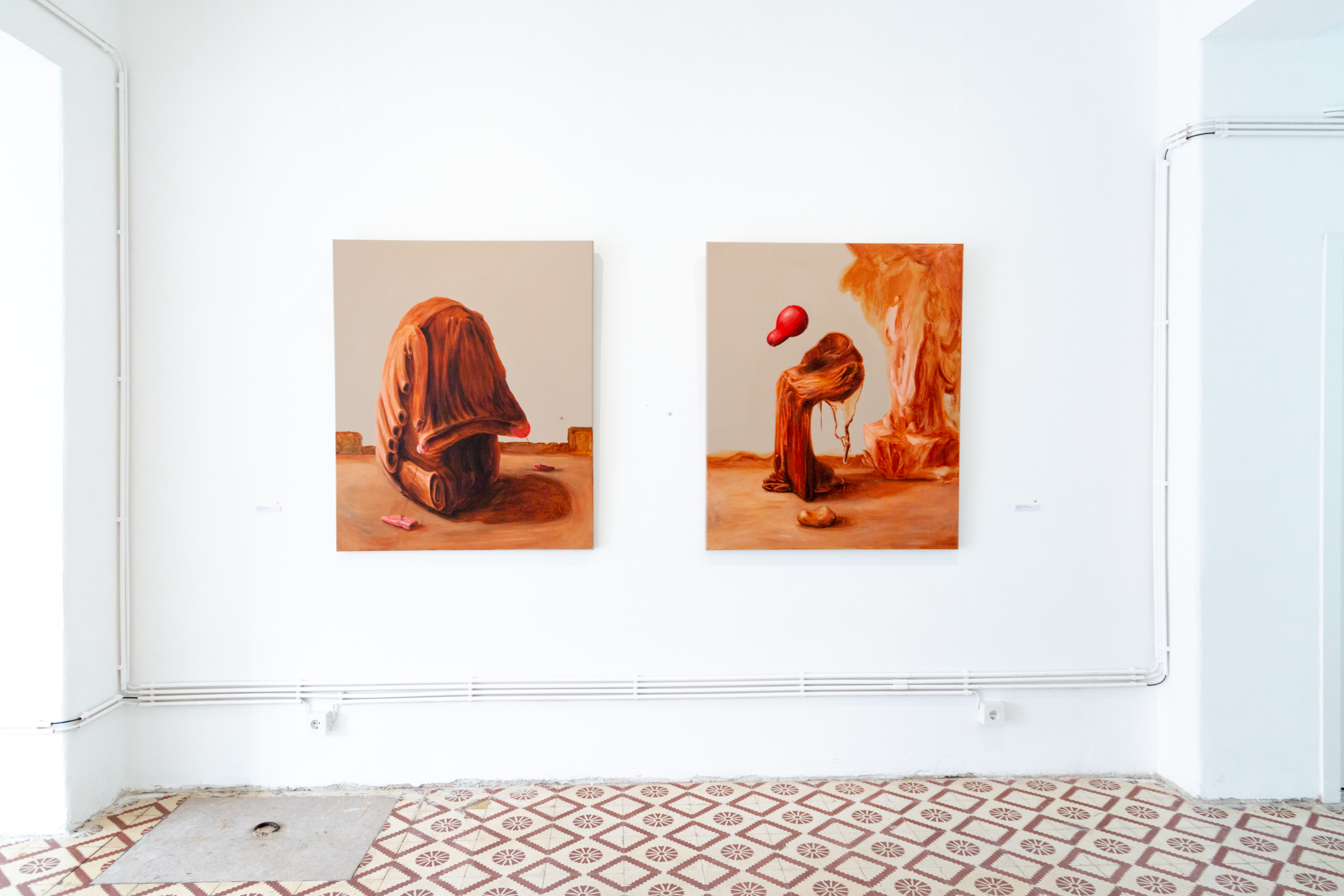
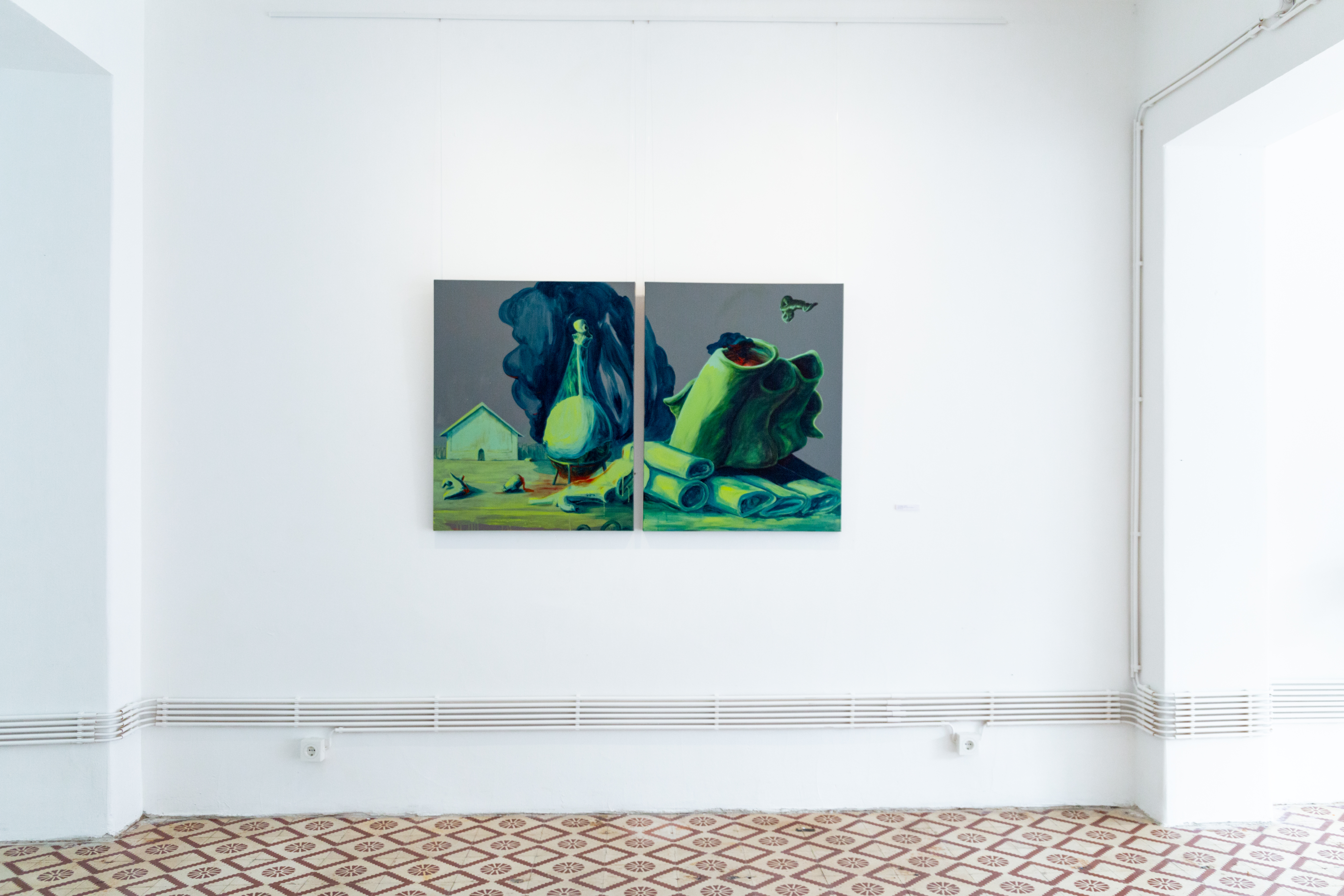
PT
Virtude.
Fundo.
Palavra.
Este é o diálogo de Teresa Murta, que em forma de palestra de representações pictóricas e imagens que ultrapassam a realidade, nos caricia a sensibilidade.
Murta, com a sua pintura confunde-nos através de emoções impulsionadas por representações disformes, de formas incongruentes e inquietantes, mas de vigorosa identidade quotidiana. Sem modificar ou deturpar a realidade, também não a interpreta, e nem mesmo é a expressão ou extensão de si própria.
A sua obra é a vivacidade de uma não-realidade, de um universo do que não é, nem está, e que desenvolve através da liberdade do seu traço directamente na tela, sem esboço ou roteiro preconcebido, numa sinfonia sensorial emprenhada pelo surrealismo onde o sonho predomina. Uma pintura metafísica que nos conduz num ambiente misterioso onírico, e de enorme simbologia.
Estar perante a obra de Teresa Murta, é um mergulho num mundo onde a realidade das coisas simples e puras, é contaminada pelo pensamento que vive nos nossos olhos. O trabalho exposto em Absurdo, talvez seja a transição mais eloquente da carreira de Teresa Murta. Por absurdo talvez seja, porque é o mais emotivo, e o mais comovedor - Quando começamos a abrir os olhos para o visível, há muito que já estávamos pegados ao invisível – assim diria o poeta D’Annunzio.
Mercedes Cerón, curadora e fundadora da NAVE
Novembro, 2019
ENG
Virtue.
Deep.
Word.
This is the dialogue of Teresa Murta, who in the form of a lecture of pictorial representations and images that go beyond reality, caresses our sensitivity.
Murta, with her painting, confuses us through emotions driven by misshapen representations, in incongruous and disturbing forms, but with a vigorous daily identity. Without changing or distorting reality, it also does not interpret it, nor is it the expression or extension of itself. Her work is the vivacity of a non-reality, of a universe of what is not, which develops through the freedom of her stroke directly on the canvas, without a preconceived sketch or script, in a sensory symphony impregnated by the surrealism where dreams predominate. A metaphysical painting that leads us into a mysterious dreamlike environment with enormous symbolism. Facing Teresa Murta’s work is a plunge into a world where the reality of simple and pure things is contaminated by the thought that lives in our eyes.
The work exposed in Absurdo is possibly the most eloquent transition in Teresa Murta’s career. Perhaps absurdly because it is the most emotional and the most moving - When we start to open our eyes to the visible, we had long been attached to the invisible – as the poet D’Annunzio would say.
Mercedes Cerón, curadora e fundadora da NAVE
Novembro, 2019
Solo Exhibitions
Rock. My World
2019
︎Nave
Travessa do Noronha n11 B
Lisboa
Rock. My World
2019
︎Nave
Travessa do Noronha n11 B
Lisboa

PT
“Showcase ROCK. MY WORLD é um representativo do estudo da obra de Murta. Um convite de consentimento absoluto e de encaminhamento para uma expedição imaginária arguciosa, carregada de carácter dinâmico e de crescimento, que caracterizam a expressão artística inefável de Teresa Costa Gomes.
A obra exposta, manifesta uma metafísica de clara interpretação pessoal com base na sua percepção de lembrança, memória de infância, cor, forma e emoção, que através de uma imagem suscita outras É uma idealidade de um surrealismo sem escala, de correspondências dinâmicas entre objetos,espaços, experimentação humana e cognitiva visual que reporta ao ‘instante poético’ de Gaston Bachelard como - o momento de criação artística.”
Mercedes Cerón, curadora e fundadora da NAVE
Novembro, 2019
Solo Exhibitions
Rock. My World
2019
︎Art Room
Pátio do Tijolo n1
Lisboa
PT
“Nesta mostra, são apresentados os trabalhos mais recentes de Murta - uma série de pinturas desenvolvidas à volta de uma única memória - mas com resultados muito diferentes entre si.
The rock, a pedra que Teresa levantava, quando era criança para descobrir o que se passava por baixo deixava uma marca clara na terra - separava o verde do castanho, o frio do quente, o seco do húmido - e criava, entre as cores e texturas, um vector singular, um muro imaginário.
Neste recreio, os bichos corriam tão freneticamente que era impossível focar. A pedra caía com a estranheza e tudo voltava a ser tapado. Ficava o vazio do que ficou por ver. Murta, utiliza a forma desta pedra como ponto de partida. Depois, em cima, à volta, por cima e em baixo, o que ficou desfocado outrora, tem agora estrutura, volume e vive estático na composição, como algo que congelou e finalmente pode ser analisado. No processo, cada pintura toma um rumo diferente e as composições únicas são o resultado da experiencia do material e do que todas as pequenas decisões vão sugerindo.
São modeladas formas, outras vão sendo tapadas por tinta e algumas deixam só o seu rasto. Existe recorte, síntese, e modelação. A artista dá-nos a conhecer vários desfechos possíveis para a mesma primeira estória.
O trabalho de Murta é um processo de descoberta constante, tanto de si própria, como dos materiais com
que pinta e luta diariamente, e por isso a paisagem e “quem a habita” altera-se de tela para tela.
Na exposição poderão deambular por um mundo bidimensional de bichos sem nome, jazidos numa quase
natureza morta, num recreio encenado. Iluminado por uma luz clínica, e representados antes de serem compreendidos - o mundo de Murta.”
Teresa Murta
Solo Exhibitions
IN>SIDE<OUT
2017
︎Wozen
Rua das Janelas Verdes 128
Lisboa
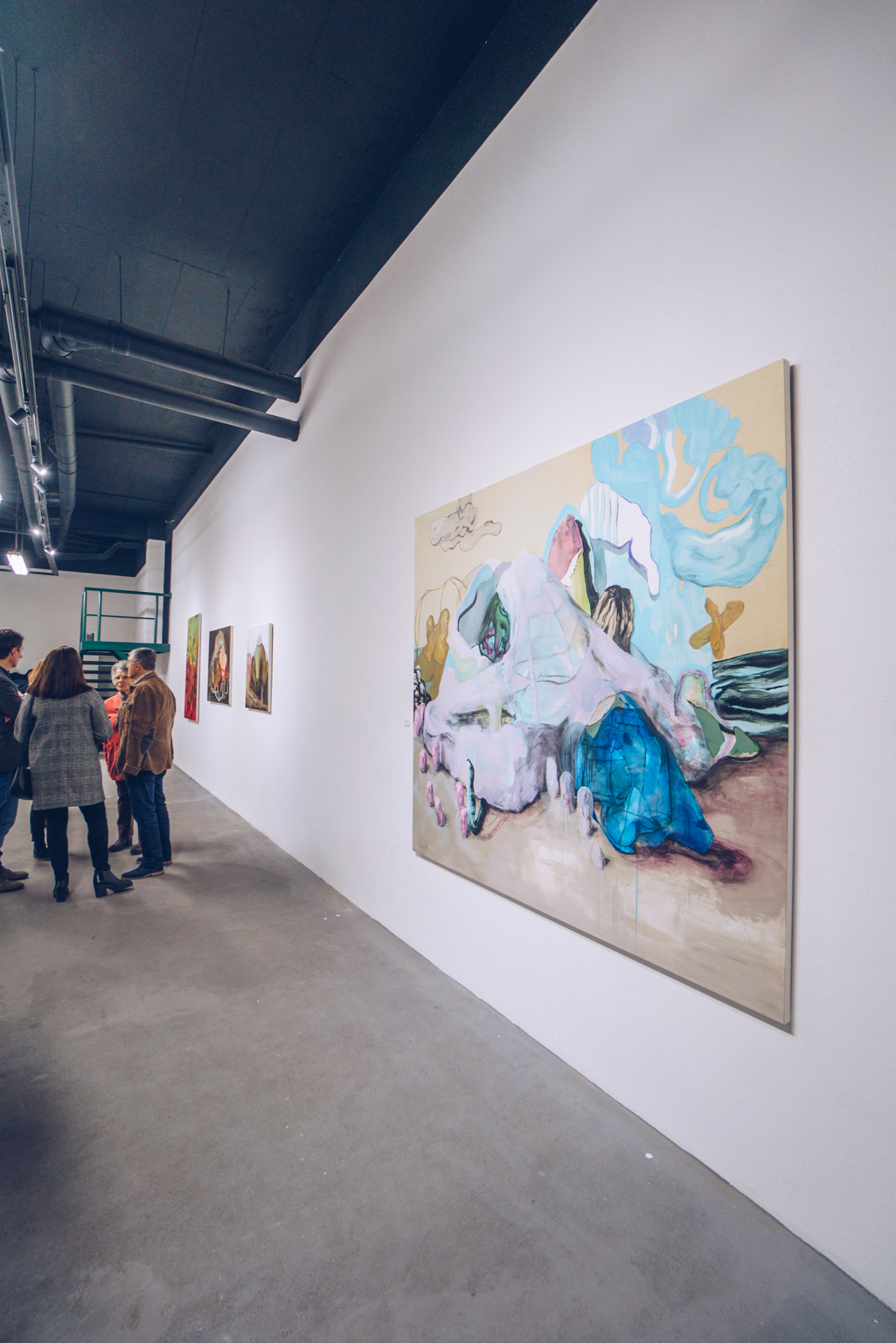

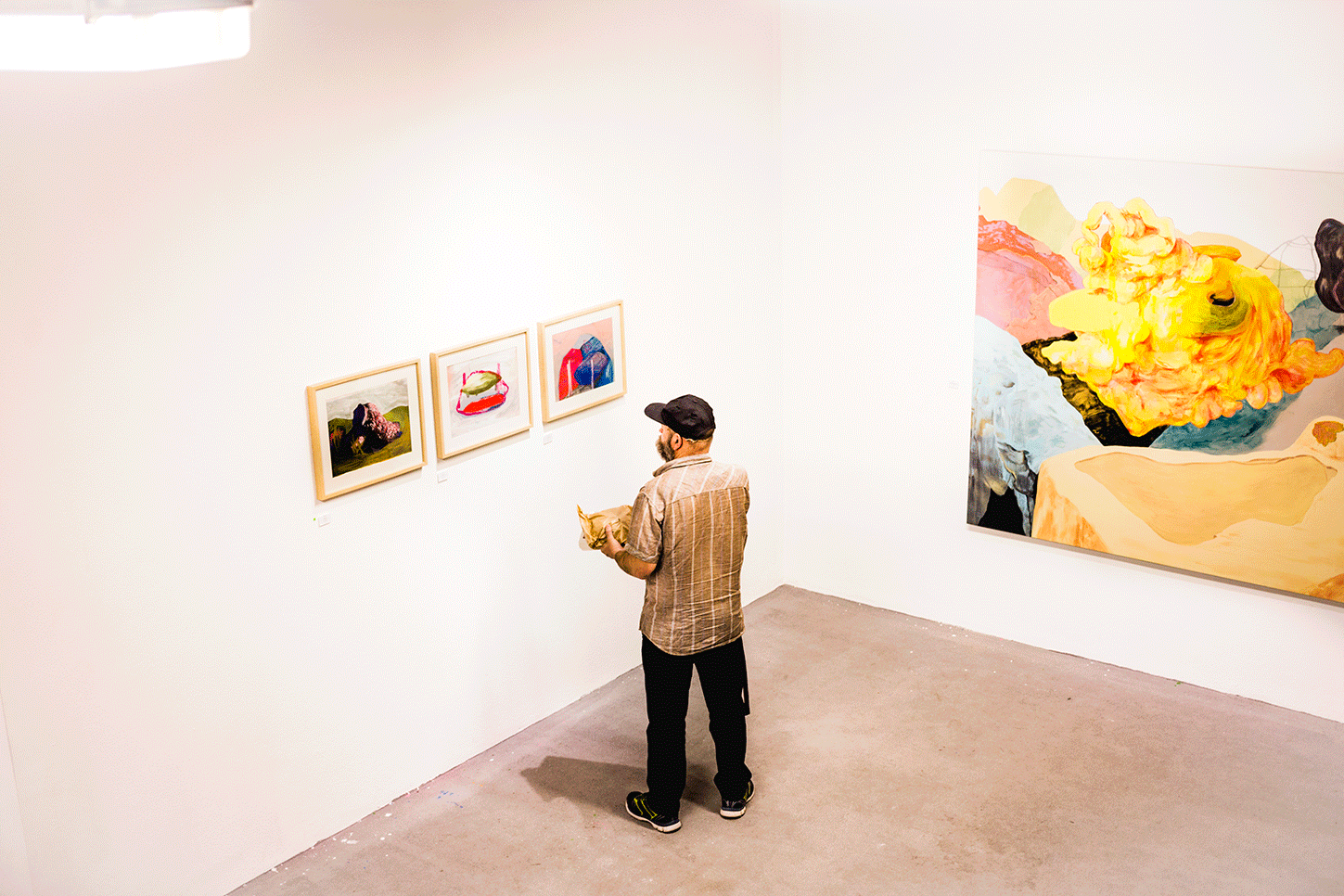
ENG
“For the exhibition "IN>SIDE<OUT", her first solo at Wozen Gallery, MURTA explores her favorite theme: memory. One of her first recollections as a child was the game of moving rocks off of their original sites, anxious about the new organic worlds living on the dirt bellow them. This is the starting point for the difficult artistic exercise of investigating and visually representing the ephemeral existence of a memory inside the subconscious mind, as well as the resulting discovery of dormant feelings that return when this specific moment is visited.
This search for memory molds the artist`s unique painting style, creating spontaneous compositions of volume and texture, with powerful and instinctive brushstrokes, insinuating an unintentional figuration within the "pure" abstraction. Her vast use of opaque and dark colors finds transparency inside the juxtaposition of layers of lighter and vivid colors, reaching depth, focus and perspective, although never on a concrete or deliberate path.
MURTA understands a memory as an occult and vague fragment of consciousness, veiled under many layers of other memories. Such as the child`s play, each of her pieces brings an invitation for the public to recollect past special moments and all the latent feelings they evoke. "IN>SIDE<OUT" is an opportunity to discover the memories hidden under the rocks of time.”
Rique Inglés